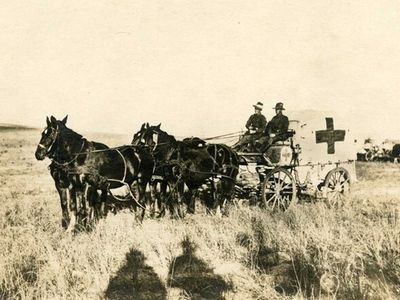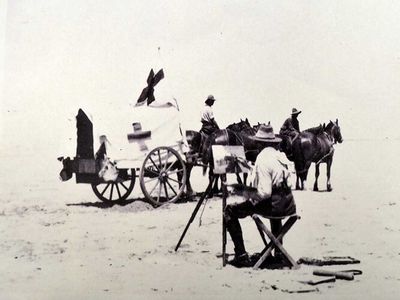“Major Avery, among many other Old Boys, holds a special place on the TGS Old Boys’ Wall of Achievement for his role in inventing the “Rapid Transit Ambulance” that was a key part of the Australian Light Horse Brigade.”

On ANZAC Day, we come together to reflect on the importance of service and sacrifice.
Toowoomba Grammar School would like to acknowledge our admiration for the loyalty, service and bravery exhibited by TGS Old Boys who so valiantly served. We are all the beneficiaries of their sacrifice, and their selfless actions continue to inspire a spirit of service amongst our current students.
Today we focus on the contribution of one TGS Old Boy who made a significant contribution to World War I. Here is some of the incredible story of Major Avery, DSO and if you visit the School Museum and Archives you can see a display in his honour.
Much of this history has been captured through countless hours of dedication and devotion by current TGS museum volunteer and former TGS staff member, Mrs Ann Hallam who managed the School’s Cadet Unit from 2006-2019.
Major Avery DSO, inventor of the WWI “Rapid Transit Galloping Ambulance”
Distinguished TGS Old Boy, Leonard Grimes (1880-1885) was born in Queensland in 1869 and died in 1953. Grimes attended the School in the days of Sir Harry Chauvel and Sir Littleton Groom and while at TGS was known as Leonard Avery Grimes.
After his School days he went on to Wadham College, Oxford, where he graduated with a medicine degree. He later changed his name to Conrad Avery and after some years as a hospital physician and surgeon, Avery enlisted with the British Army and joined the Suffolk Imperial Yeomanry. He was later promoted to Major and joined the Royal Army Medical Corps. During World War I he was enlisted with the Royal Westminster Dragoons and served in Palestine, Egypt and Syria.
Major Avery, among many other Old Boys, holds a special place on the TGS Old Boys’ Wall of Achievement for his role in inventing the “Rapid Transit Ambulance” that was a key part of the Australian Light Horse Brigade.
Light Horse Field Ambulance
The Light Horse units were mounted infantry with efficient mobile medical support to the wounded and sick soldiers of an Australian Light Horse Brigade. The Field Ambulance ensured the removal of the wounded from the front line to the advanced dressing station where there were surgical and resting tents.
These sand carts had two wheels with tyres that were wide enough to stop the cart digging into soft sand and could carry two or three stretchers. In heavy sand four horses were necessary to pull the cart, and the cart had to be steered by a rider on one of the lead horses.

Australian Light Horseman
The 2nd Light Horse Field Ambulance was formed in Brisbane with much of the unit coming from Queensland.
More than 15 TGS Old Boys enlisted with the Second Light Horse Brigade, two of whom died at Gallipoli: Major Dugald Maxwell Lockwood Graham and Trooper Gordon Holmes Robertson.
During the World War I, George W. Lambert (1873-1930) served Australia as an Official War Artist attached to the ANZAC Mounted Division. He spent two terms in service, the first with the Light Horse in Palestine, and the second in Gallipoli and Egypt before his military contract discharge.
As a result of Lambert’s service during World War I, he was offered a variety of commissions to paint scenes from significant war time events, including an activity of the 2nd Australian Light Horse Field Ambulance, Walk (An Incident at Romani).
The Battle of Romani was the last ground attack on the Suez Canal at the beginning of the Sinai and Palestine Campaign. The battle was fought from 3 to 5 August 1916 near the Egyptian town of Romani.
The completed painting was to be given to the Queensland (National) Art Gallery by the Light Horse in memory of their fallen comrades.
The Rapid Transit Ambulance
Major Avery describes his vision for a new galloping ambulance, known as “The Rapid Transit Ambulance”.
This ambulance was designed with a view to filling the want of stretcher bearers with mounted troops. The endeavor has been to construct a light strong carriage easily adjustable to any mounted horse and capable of keeping up with cavalry through any sort of country. As will be seen from the accompanying illustration, the ambulance is a two-wheeled contrivance.
The body consists of a platform fixed to a crank axle by long springs between 46-in. wheels. This platform is 2 ft. 3 in. from the ground and is arranged to carry an ordinary service stretcher. The forepart consists of a pair of short shafts which are attached to the body by an arrangement of springs adapted to prevent the side-to-side motion caused by the action of the horse. The shafts reach as far forward as the saddle flaps, where they are held in position by a girth strap, breastplate, and belly-band.
The body is covered by a canvas hood. The weight is about 3 cwt. Length overall, 12 ft. Track, 4ft. 1 in. Surgical dressings, splints, water-bottle, &c., are carried. It is quite easy for the driver, having placed a wounded or helpless man in a stretcher, to transfer him from the ground to the platform of the carriage single-handed.
This ambulance has been on duty with the Suffolk, Sussex, Surrey and Middlesex Imperial Yeomanry during their respective training, and with the Wiltshire Yeomanry through the recent maneuvers. It is a very comfortable conveyance and has proved capable of negotiating with almost any country.
Walk (An Incident at Romani)
The incident to which Lambert’s painting refers occurred during the Battle of Romani on 4 August 1916. The 2nd Light Horse Field Ambulance had deployed two sand-carts to an exposed part of the line to retrieve some seriously wounded men. Upon its return journey the Field Ambulance envoy came under Turkish fire and its panicked horses started to bolt.
Tragedy was averted when the corporal signaled ‘Walk’ and galloped to the front of the party to steady the teams. After the horses had been calmed and resumed their pace, the enemy apparently recognised the Ambulance’s mission and averted their fire. As a result of their bravery and composure during the incident the corporal and drivers were awarded Military Medals.

To enable Lambert to make sketches of the event that was already three years in the past, it was re-enacted at Kantara, Egypt in 1919. Photographs were taken of Lambert at work sketching this re-enactment. The completed painting portrays the moment when the corporal signals ‘Walk’ whilst rushing to the front of the group to steady the bolting teams.
Remembrance Day
Remembrance Day marks the anniversary of the Armistice which ended the First World War, signed at 11:00am on 11 November 1918. We still remember those who have given their lives in conflict before and since, by taking a minute to stop, be silent and remember the war that was to end all wars.
Latest Blog
Outdoor Pursuits and Activities Week - Developing Good Character Beyond the Classroom
We offer a range of enrichment activities for our boys, but the last week of Term 1 is a very special opportunity for all of our Senior School students. It's Outdoor Pursuits and Activities Week, which provides age-appropriate physical challenges in a safe, well-supervised environment. Activities on the various camps may include ropes courses, rock climbing, bodyboarding, surfing, mountain biking and canoeing. The aim is to foster a love of the outdoors and an appreciation of the environment.…
Stories behind key TGS staff helping shape our students
It was my great privilege to join TGS as Head of House - Boyce Boarding in 2024. The opportunity to lead these young men of character on their TGS journey carries great weight but is also enormously exciting. Embarking upon this project alongside my wife Meg as Boyce Boarding House Manager strengthens the team further. I am hopeful that we will demonstrate to the boys how positive relationships can foster a warm and supportive environment. I know that many of our boys are familiar with strong…
More Than Just an Education and That Makes All the Difference
Toowoomba Grammar School excels in its extensive co-curricular programs, particularly in performing arts and sports. Our boys learn that success comes from hard work and dedication. This ethos is inspired by quotes like “You don’t have to be great to start, but you have to start to be great,” “The harder I work, the luckier I get” and the words emblazoned on our P.B. Hauser Aquatic Centre wall “Success is the celebration of preparation.” These opportunities allow students to excel in programs…
Stewardship: Leading the Way in Safety, Sustainability and Security
However, the challenges facing the Director of Facilities, Mr Bengie Dickeson and the Director of Information Technology, Mr Ron Robinson certainly are. This month's weather has been nothing if not unpredictable and it's in those conditions that both these men's skills come to the fore. With Tropical Cyclone Alfred and its threat to our School campus and community - Mr Bengie Dickeson and Mr Ron Robinson played integral roles in keeping everyone and everything on our 150-year-old campus safe.…
Pursuing New Horizons in Horticulture
Jake Moon is a sixth-generation primary producer. He is dedicated to agriculture and is currently working at his family’s St George farming enterprise, tackling some of the sector’s biggest challenges. The 28-year-old says his family moved to the St George irrigation precinct in 1978, initially growing rockmelons and watermelons, hence the business name Moonrocks. Seasonal and market changes led them to switch crops frequently, growing grapes, broccoli and even wax flowers over the years.…
Crushing it at Cricket and Conveying Culture
He explains that he’s named after Yarramundi, a respected and influential leader of the Richmond tribes of the Dharagnora (Hawkesbury-Nepean region of New South Wales) and a respected elder of the Boorooberongal clan of the Dharug people. “I’m proud of my culture and excited to have just started learning Dharug Dalang as part of the language revitalisation with my family.” During one week late last year he juggled exams, balanced representative cricket in Mackay with being the emcee of the…
Disappointment: A Necessary Part of School Life
Schools are inherently hopeful and happy places. Their natural focus on growth, connectedness and preparing youth for a better future creates an optimistic atmosphere in which ambitions are born. These positive emotions and experiences lay the foundation for our expectations and while these can be highly motivating, they come with a catch: the greater our expectations, the greater the disappointments, too. Disappointment is not a popular feeling. Rightly so, not many of us wish to feel sad,…
Boys and Belonging at TGS
As a boarding master of adolescent boys, my role fundamentally concerns pastoral wellbeing and character development to support a successful academic journey. A positive sense of belonging — where boarders feel safe, supported and heard — is fundamental to an effective boarding environment. As such, I felt there was a distinct connection between the International Boys’ Schools Coalition’s (IBSC) theme for the 2024–25 Action Research Cohort, “Boys and Belonging” and what I believe is best…
Fostering Growth and Resilience
This philosophy is vividly demonstrated through our Junior School MATES program, an initiative designed to equip boys from Prep to Year 6 with the skills they need to thrive both in and out of the classroom. Year 6 leader Hugo Seaby epitomises what the program is all about. As a leader in Stephens House, he explains its importance: “It’s about spending time with the younger boys and learning about honesty, respect, kindness and other attributes like that.” He said that it’s helpful for the…